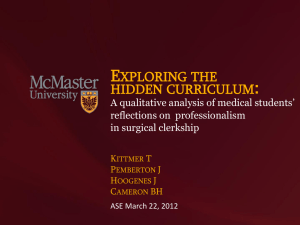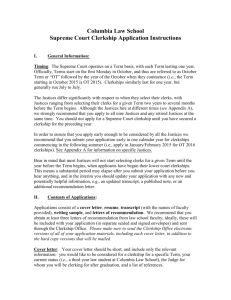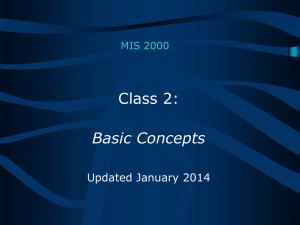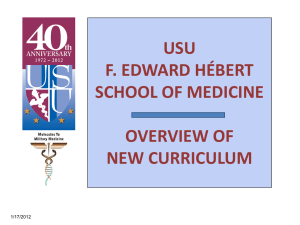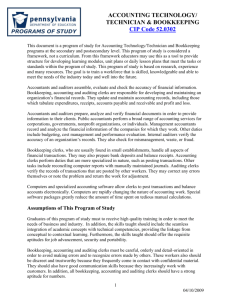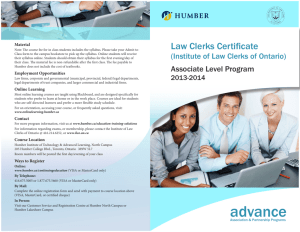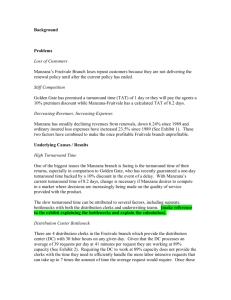Position Paper on Clinical Clerk Environment
advertisement
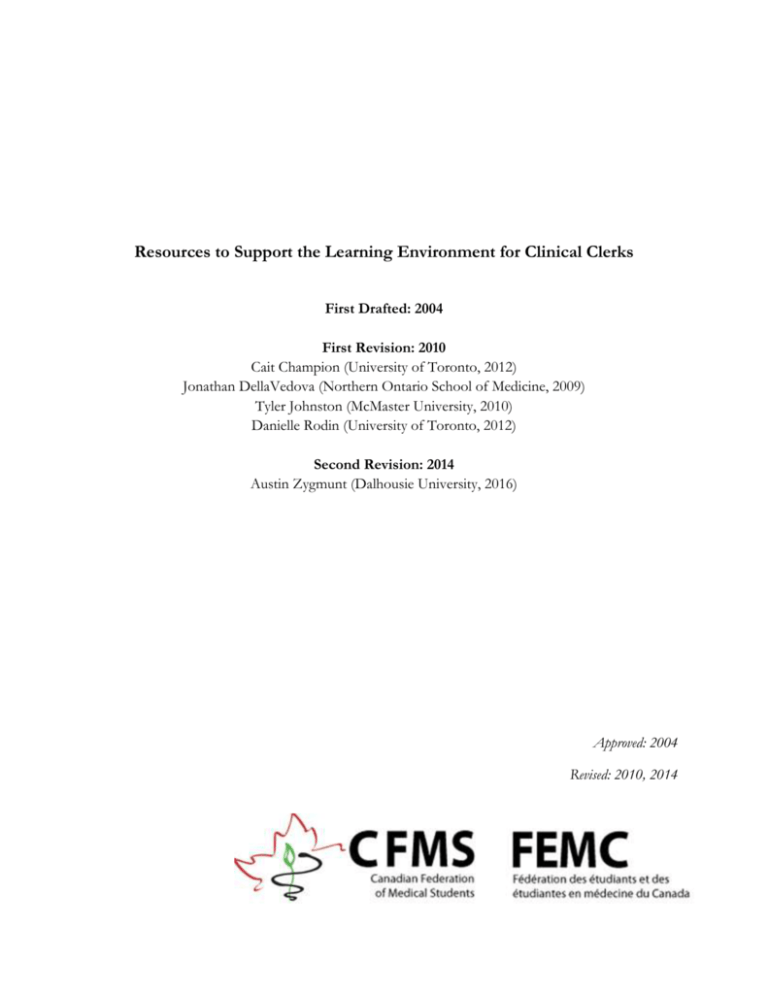
Resources to Support the Learning Environment for Clinical Clerks First Drafted: 2004 First Revision: 2010 Cait Champion (University of Toronto, 2012) Jonathan DellaVedova (Northern Ontario School of Medicine, 2009) Tyler Johnston (McMaster University, 2010) Danielle Rodin (University of Toronto, 2012) Second Revision: 2014 Austin Zygmunt (Dalhousie University, 2016) Approved: 2004 Revised: 2010, 2014 Background The clinical learning environment plays an important role in medical education through structured rotations and opportunities available to medical students. In the early stages of training, medical students often act as clinical observers with limited patient interaction and no patient care responsibilities. In later stages of training, medical students become clinical clerks and engage in fulltime patient care responsibilities in partnership with hospital house staff. Optimal clinical experiences require the provision of an environment that is safe and conducive to learning. Each Canadian medical school has policies focused on the clinical learning experiences at their institution but many of these policies do not fully address the protections and supports necessary for medical student learning in clinical settings. As the national representative body of Canadian medical students, the CFMS/FEMC endorses the following principles and recommendations regarding a safe and supportive environment for medical student learning and development. We believe these principles and recommendations support the important goals of effective medical education and good patient care, and that all Canadian medical students would benefit from their implementation. We hope that this document will serve as a framework for discussion among Canadian medical schools, their faculty and their students with regard to the implementation of safety and support standards in clinical learning for medical students. Principles 1. Medical students have a responsibility for taking ownership of their education and facilitate the best possible learning experience. They should strive to maintain a high degree of professionalism in their interactions with patients, peers, faculty, and staff. 2. Medical students should not be expected to make clinical decisions beyond their level of training and should not be discouraged from or reprimanded for acknowledging these limitations to staff or residents. 3. Medical students have the right to work in an environment free of harassment and coercion from other students, residents, staff members, or patients. Recommendations 1. Expand medical school and hospital policies to increase resources to clinical clerks to support their learning In order to enable medical students to focus on educational opportunities during their clinical rotations and minimize administrative details, they should be provided with access to appropriate support and resources, that include but are not limited to: Overview of clinical responsibilities, working arrangements, and academic activities1 Providing proper assessment and feedback1 Coverage of reasonable living expenses when completing mandatory rotations away from their primary residence such as accommodations and travel expenses2,3 Training on occupational health and patient safety involving topics such as preventing medication errors and maintaining sterile conditions4,5,6 Training for appropriate use of electronic health records7,8 Training for effective handoffs and discharge planning including clarification of roles and responsibilities, appropriate details of the patient’s medical course, and identifying providers involved in the transition 9,10,11,12 Strategies for supporting personal and professional development in areas such as selfwellness, time management, and professionalism13,14,15 2. Undergraduate medical offices should support clinical clerks in their personal and professional development In order to support their ongoing development, medical students should have access to protected time-off away from clinical duties in situations that include but are not limited to: Conferences, seminars, and teaching sessions for educational or research purposes16 Meetings as representatives for organizations or committees in an official capacity at local, provincial, national, or international levels17 Support career planning including adequate time to attend their CaRMS interviews18,19 Non-paid parental or maternal leave as defined by the Government of Canada20 Compassionate leave as defined by the Government of Canada for a serious life event which would prevent a clinical clerk from carrying out their necessary duties21 3. Medical schools and hospitals should update and revise policies concerning the safety and security of clinical clerks In order to provide safety and security to their clinical clerks, medical schools should update and revise policies to ensure mechanisms that include but are not limited to: Access to a secure area within the clinical setting in which to store their belongings such as staff rooms, private lockers or secure offices22 Secure sleeping facilities for in-house call that have appropriate security measures such as locked doors and storage Adequate after-hours support upon completion of call and late night shifts in the form of on-site security and safe transportation home Relieving clerks from service who are post “in-house” call after appropriate patient handover in accordance with the collective agreement for the house staff in their respective provinces Clinical clerks should not be coerced into working longer hours23,24 Respecting clinical clerks and preventing their mistreatment through verbal and power abuse25,26 References 1. Henning, M.A., Shulruf B., Hawken S.J., & Pinnock R. (2011). Changing the learning environment: the medical student voice. Clinical Teacher, 8 (2): 83-7. 2. Health Force Ontario. (2013, May 7). Clerkship Travel Program Frequently Asked Questions. Retrieved from http://www.healthforceontario.ca/en/M4/Clerkship_Travel_Program/ Frequently_Asked_Questions 3. Schulich School of Medicine & Dentistry. (2012, January) Clerkship Travel and Accommodation Policy. Retrieved from http://www.schulich.uwo.ca/swomen/clerkshiptravelpolicy 4. Daud-Gallotti, R.M., Morinaga, C.V., Arlindo-Rodrigues, M., Velasco, I.T., Martins, M.A., & Tiberio, I.C. (2011). A new method for the assessment of patient safety competencies during a medical school clerkship using an objective structured clinical examination. Clinics, 66 (7):1209-15. 5. Mollo, E.A., Reinke, C.E., Nelson, C., Holena, D.N., Kann, B., Williams, N., Bleier, J., & Kelz, R.R. (2012). The simulated ward: ideal for training clinical clerks in an era of patient safety. Journal of Surgical Research, 177 (1): e1-6. 6. Seiden, S.C., Galvan, C., & Lamm, R. (2006). Role of medical students in preventing patient harm and enhancing patient safety. BMJ Quality and Safety in Health Care, 15 (4): 272-6. 7. Hammoud, M.M., Margo, K., Christner, J.G., Fisher, J., Fischer, S.H., & Pangaro, L.N. (2012). Opportunities and challenges in integrating electronic health records into undergraduate medical education: a national survey of clerkship directors. Teaching and Learning in Medicine, 24 (3): 219-24. 8. Nie, Y., Li, L., Duan, Y., Chen, P., Barraclough, B.H., Zhang, M., & Li, J. (2011). Patient safety education for undergraduate medical students: a systematic review. BMC Medical Education, 14; 11:33. 9. Liston, B.W., Tartaglia, K.M., Evans, D., Walker, C., & Torre, D. (2014). Handoff practices in undergraduate medical education. Journal of General Internal Medicine, 29 (5): 765-9. 10. Bray-Hall, S., Schmidt, K., & Aagaard, E. (2010). Toward safe hospital discharge: a transitions in care curriculum for medical students. Journal of General Internal Medicine, 25 (8): 878-81. 11. Koch, P.E., Simpson, D., Toth, H., Marcdante, K., Densmore, E., Young, S., Weisgerber, M., Morzinski, J.A., & Havas, N. Clinical clerkship students' perceptions of (un)safe transitions for every patient. Academic Medicine, 89 (3): 477-81 12. Arora, V.M., Eastment, M.C., Bethea, E.D., Farnan, J.M., & Friedman, E.S. (2013). Participation and experience of third-year medical students in handoffs: time to sign out? Journal of General Internal Medicine, 28 (8): 994-8 13. Kligler, B., Linde, B., & Katz, N.T. (2013). Becoming a doctor: a qualitative evaluation of challenges and opportunities in medical student wellness during the third year. Academic Medicine, 88 (4): 535-40. 14. Lown, N., Davies, I., Cordingley, L., Bundy, C., & Braidman, I. (2009). Development of a method to investigate medical students' perceptions of their personal and professional development. Advances in Health Sciences Education, 14 (4): 475-86 15. Bernard, A.W., Malone, M., Kman, N.E., Caterino, J.M., & Khandelwal, S. (2011) Medical student professionalism narratives: a thematic analysis and interdisciplinary comparative investigation. BMC Emergency Medicine, 12; 11:11 16. Queen’s University Undergraduate Medical Education. (2014). Conferences. Retrieved from http://meds.queensu.ca/education/undergraduate/current_students/funding_for_conferences 17. Dalhousie University Faculty of Medicine. (2014). Policy for Student Requests for Academic or Personal Leave During Clerkship. Retrieved from http://www.medicine.dal.ca/content/dam/ dalhousie/pdf/faculty/medicine/departments/core-units/undergrad/ClerkshipTimeOff Policy_112012.pdf 18. Zink, B.J., Hammoud, M.M., Middleton, E., Moroney, D., & Schigelone, A. (2007) A comprehensive medical student career development program improves medical student satisfaction with career planning. Teaching and Learning in Medicine, 19 (1): 55-60. 19. Levine, R.B., Cayea, D., Shochet, R.B., & Wright, S.M. (2010). Case study: a midclerkship crisislessons learned from advising a medical student with career indecision. Academic Medicine, 85 (4): 6549. 20. Treasury Board of Canada. (January, 2013). Parental/Maternity Leave. Retrieved from http://www.tbs-sct.gc.ca/hr-rh/bp-rasp/mb-mav/pml-cpcm-eng.asp 21. Service Canada. (2013). Compassionate Care Benefits. Retrieved from http://www.servicecanada.gc.ca/eng/ei/faq/faq_compassionate_care_individuals.shtml 22. Liaison Committee on Medical Education. (2013, June). Functions and Structure of a Medical School- The Learning Environment: MS-37. Retrieved from http://www.lcme.org/publications/ functions2013june.pdf 23. Runyan A. (2013). Duty hour reform: only a small piece of a larger problem. JAMA Internal Medicine, 28; 173 (19):1844 24. Friedman, E., Karani, R., & Fallar, R. (2011). Regulation of medical student work hours: a national survey of deans. Academic Medicine, 86 (1): 30-3 25. Fried, J.M., Vermillion, M., Parker, N.H., & Uijtdehaage, S. (2012). Eradicating medical student mistreatment: a longitudinal study of one institution's efforts. Academic Medicine, 87 (9): 1191-8. 26. Karnieli-Miller, O., Taylor, A.C., Cottingham, A.H., Inui, T.S., Vu, T.R., & Frankel, R.M. (2010). Exploring the meaning of respect in medical student education: an analysis of student narratives. Journal of General Internal Medicine, 25 (12): 1309-14
